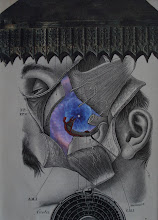Here is my latest piece entitled "Thank you John, I absolutely loved Paris" (8" x 10"). Once again, this piece is inspired by John Stezaker's work (his approach seems to be in my monkey brain right now). I am preparing a presentation for a conference in Athens, GA in the fall featuring much of his work. I am interested in the intersection of psychology, neuroscience and art and will talk about "face detectors" in the temporal lobe of the brain as it might relate to the strategy that Stezaker and others use when considering composition in art. I can elaborate more on that in the near future. For now, I would like to say a bit more about this piece. A common question that I am asked is "How long does it take you to do a collage?" This is a great question; but one that is difficult to answer precisely. This piece consists of only two elements (like much of Stezaker's work). Couldn't have taken me too long to do it, right? Well, here's the complicated answer… The base image is "Miss Theresa Nettles" (which is interesting in and of itself and one of my dearest friends is named Tom Nettle) which was taken from an old yearbook. I believe it was from a 1963 Louisiana State University yearbook (Theresa, are you out there?). I have had that image in my collection for about a year wondering what I was going to do with it. I have tried different things from time to time, but never "pulled the trigger" by using her in a collage. Last night as I was looking through my collection and trying all sorts of combinations ("doing collage 'sketches'" as I like to refer to it), I once again brought Theresa to the table. I had the nice vintage image of the arch for a couple months (BTW, the image is vintage, the paper is not. I think it was from a calendar). Anyway, I placed the arch over Theresa and things seemed to line-up in an interesting Stezaker-esque way; so I "went for it". Trimming the edges more took me about an hour. Then I delicately paint the cut edges with Golden neutral gray paint. After that, I need to coat and cut the substrate and carefully determine exactly the placement that will make the piece "pop". How does one "count" the time to acquire the sources of images, peruse them and choose which to use in the future? How does one "count" the time the images stay within a collection before they are selected and manipulated? The actual technical placing and adhering of the images takes little time. But I don't think that where the "art" comes from, in a way. So, the answer is complicated for sure. This two-element composition is a good example of that complexity methinks.










